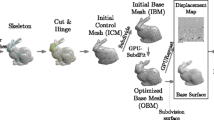Abstract
Regarding the modeling aspects of computer animation, the skeletal animation is a newfangled modeling technology to assist in single-mesh model animation. There are two aspects of advancement proposed in this paper. First, we construct a novel vertical data structure (Modified Body-Tree) to describe the skeletal models in animation. Second, instead of normal methods such as linear interpolation and higher-order spline interpolation to generate in-between frame, we proposes an adaptive and high-performance algorithm based on 4-Point subdivision scheme to generate in-between frame in the skeletal animation. By this advanced algorithm, a smoother skeletal animation with blander vision effect is achieved.
Preview
Unable to display preview. Download preview PDF.
Similar content being viewed by others
References
Xiaonan, L., Ning, L., Chenyin, G.: Fairing geometry modeling based on 4-Point interpolatory subdivision scheme. Journal of Computational and Applied Mathematics 163(1), 189–197 (2004)
Dyn, N., Gregory, J.A., Levin, D.: A 4-Point interpolatory subdivision scheme for curve design. Computer-Aided Geometric Design 4, 257–268 (1987)
Deslauriers, G., Dubuc, S.: Symmetric iterative interpolation. Constructive Approximation 5, 49–68 (1989)
Fan, Z., Xiaonan, L., Peng, C.: Application of 4-Point Subdivision to Skeletal Animation. Journal of Information and Computational Science 1:1, 163–167 (2004)
Author information
Authors and Affiliations
Editor information
Editors and Affiliations
Rights and permissions
Copyright information
© 2006 Springer-Verlag Berlin Heidelberg
About this paper
Cite this paper
Zhou, F., Luo, X., Huang, H. (2006). Application of 4-Point Subdivision to Generate In-Between Frames in Skeletal Animation. In: Pan, Z., Aylett, R., Diener, H., Jin, X., Göbel, S., Li, L. (eds) Technologies for E-Learning and Digital Entertainment. Edutainment 2006. Lecture Notes in Computer Science, vol 3942. Springer, Berlin, Heidelberg. https://doi.org/10.1007/11736639_134
Download citation
DOI: https://doi.org/10.1007/11736639_134
Publisher Name: Springer, Berlin, Heidelberg
Print ISBN: 978-3-540-33423-1
Online ISBN: 978-3-540-33424-8
eBook Packages: Computer ScienceComputer Science (R0)




